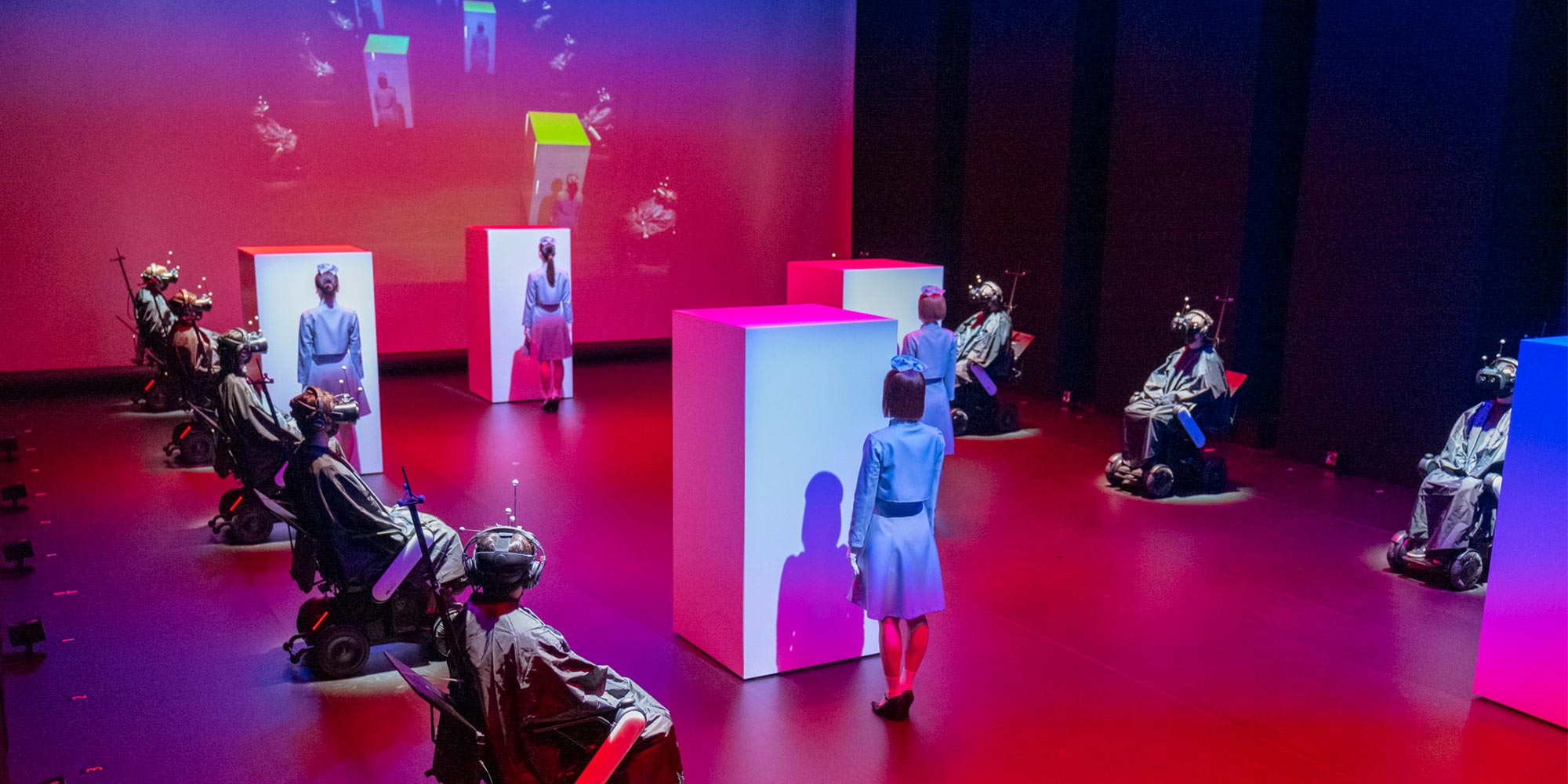Nomination
The dance company, ELEVENPLAY, the director-choreographer, MIKIKO, and the collective led by Daito Manabe and Motoi Ishibashi, Rhizomatiks, presented a dance piece border in 2015. We developed and updated our experiment of 2015 to establish a new expression model for both online and on-site experience for the post-COVID-19 era. Five years after the premiere, with border 2021 the latest version has been made. border 2021 challenges the “evolution” of experience and expression.
From border to border 2021
After the premiere of border at Spiral Hall in Tokyo in 2015, the updated version was presented at the Yamaguchi Center for Arts and Media [YCAM]. border is a work that transforms the border of the virtual and the real world. The audience sit in a WHILL (by WHILL Inc.) personal mobility device and their movements are completely controlled by the program. They also wear a Virtual Reality headset display to move back and forth between the fictional world of VR/AR and the real world brought back by the dancers to confuse various boundaries. In 2015, there were no products or services yet, and we had to make our own devices. However, in the past few years, VR devices with higher resolution have become available and it is getting more immersive and realistic. The quality of both visual and sound in the 2021 version has been improved by making the most of these innovations with newly added choreography and direction.
The emergence of online viewing models
In addition to the on-site experience, online streaming was available to establish a new expression model of post COVID-19 times. In the online viewing, viewers can select the viewpoint from multiple perspectives, which were specialized for online viewing that cannot be seen at the venue, such as a bird’s eye view of the entire venue and the control screen of the controlling software.
Credits
Agency for Cultural Affairs Visual Industry Promotion Organization (VIPO)
ELEVENPLAY: MIKIKO, SAYA, MARU, NANAKO, YU, MAI, KAORI, emmy, TOMO, MIKU, MAYU, Yoko Shiraiwa
Rhizomatiks: Daito Manabe, Motoi Ishibashi, Yuya Hanai, Satoshi Horii, Futa Kera, Katsuhiko Harada, Hideaki Tai, Toshitaka Mochizuki, Kyohei Mouri, Saki Ishikawa, Momoko Nishimoto, Naoki Ishizuka, Muryo Homma, Shintaro Kamijo, Hiroyasu Kimura, Kaori Fujii, Miku Maruno, Hirofumi Tsukamoto, Tatsuya Takemasa, Takahito Hosono, Momoko Aoyagi, Kahori Takemura, Takao Inoue
evala
Takayuki Fujimoto
mountposition
Kentaro Mito
So Ozaki, Kazuya Kushimoto
Ikumi Ijiri
Jiro Kubo
Kinya Takayanagi, 2bit, Kosaku Namikawa, Shino Higuchi
1 inc
Crescent
Yae-pon
Gnzo
TOW
Rhizomatiks (JP) is a Japanese artist group led by Daito Manabe (JP) and Motoi Ishibashi. Rhizomatiks mainly takes up projects focusing on the field of research and development and focuses on opening a new expression for the future. ELEVENPLAY (JP) is a dance company directed by choreographer & art director, MIKIKO (JP). ELEVENPLAY was founded by MIKIKO in 2009 and is composed of female dancers from a variety of genres. ELEVENPLAY’s methods of expression are diverse, including stages, video works, and still photos. Takayuki Fujimoto (JP) a.k.a. Kinsei is a director and lighting designer. Kinsei began participating in projects of the performance art group Dumb Type in 1987. He also founded his own company, Kinsei R&D, in 2015. evala (JP) is a musician and sound artist. Presents works of leading-edge electronic music and has concerts and installations in Japan and abroad.
Jury Statement
What is real and what is virtual? As technology advances, some technologies are capable of making such borders invisible. border 2021 is a project that challenges the audience with a highly immersive experience transforming the border of the virtual and the real world. With a combination of personal mobility device and VR-headset, the audience experiences an immersive performance art going back and forth between the fictional world of VR/AR and the real world brought back by the physical touches of dancers confusing various boundaries. Everything in this project moves, from physical objects, the audience on personal mobility devices, and dancers, all of which is programmed, choreographed, and performed extremely precisely. Coping with the post-COVID-19 era, the project also provides a unique online viewing experience enabling the viewers to select viewpoints of multiple perspectives such as a bird’s eye view of the entire venue, and the control screen of the controlling software. border 2021 impresses the audience with the artistic and technical quality of the implementation, the multidisciplinary collaboration, and innovative nature of how the project is pushing the boundaries of what people could perceive in the future as “real” and “virtual.”



